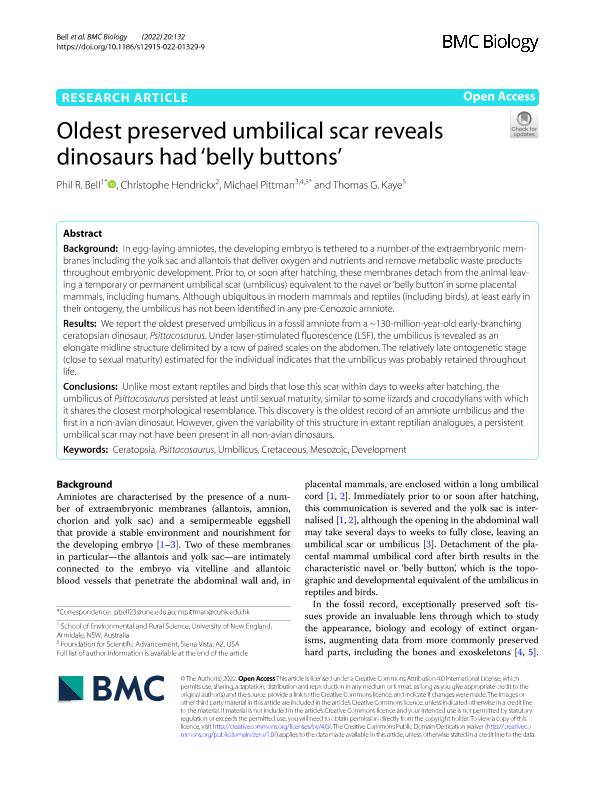Artículo
Oldest preserved umbilical scar reveals dinosaurs had ‘belly buttons’
Fecha de publicación:
12/2022
Editorial:
BioMed Central
Revista:
Bmc Biology
ISSN:
1741-7007
Idioma:
Inglés
Tipo de recurso:
Artículo publicado
Clasificación temática:
Resumen
Background: In egg-laying amniotes, the developing embryo is tethered to a number of the extraembryonic membranes including the yolk sac and allantois that deliver oxygen and nutrients and remove metabolic waste products throughout embryonic development. Prior to, or soon after hatching, these membranes detach from the animal leaving a temporary or permanent umbilical scar (umbilicus) equivalent to the navel or ‘belly button’ in some placental mammals, including humans. Although ubiquitous in modern mammals and reptiles (including birds), at least early in their ontogeny, the umbilicus has not been identified in any pre-Cenozoic amniote. Results: We report the oldest preserved umbilicus in a fossil amniote from a ~130-million-year-old early-branching ceratopsian dinosaur, Psittacosaurus. Under laser-stimulated fluorescence (LSF), the umbilicus is revealed as an elongate midline structure delimited by a row of paired scales on the abdomen. The relatively late ontogenetic stage (close to sexual maturity) estimated for the individual indicates that the umbilicus was probably retained throughout life. Conclusions: Unlike most extant reptiles and birds that lose this scar within days to weeks after hatching, the umbilicus of Psittacosaurus persisted at least until sexual maturity, similar to some lizards and crocodylians with which it shares the closest morphological resemblance. This discovery is the oldest record of an amniote umbilicus and the first in a non-avian dinosaur. However, given the variability of this structure in extant reptilian analogues, a persistent umbilical scar may not have been present in all non-avian dinosaurs.
Palabras clave:
CERATOPSIA
,
CRETACEOUS
,
DEVELOPMENT
,
MESOZOIC
,
PSITTACOSAURUS
,
UMBILICUS
Archivos asociados
Licencia
Identificadores
Colecciones
Articulos(UEL)
Articulos de UNIDAD EJECUTORA LILLO
Articulos de UNIDAD EJECUTORA LILLO
Citación
Bell, Phil R.; Hendrickx, Christophe Marie Fabian; Pittman, Michael; Kaye, Thomas G.; Oldest preserved umbilical scar reveals dinosaurs had ‘belly buttons’; BioMed Central; Bmc Biology; 20; 1; 12-2022; 1-7
Compartir
Altmétricas




